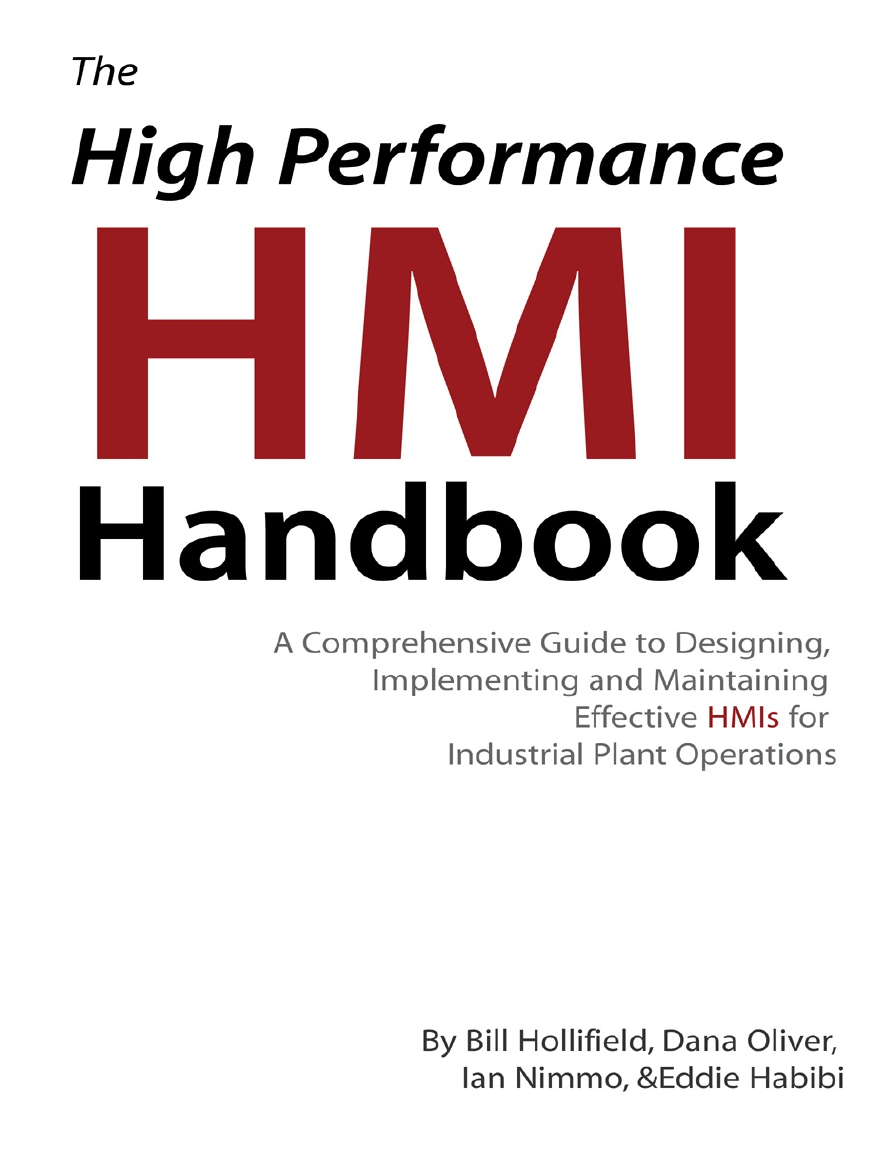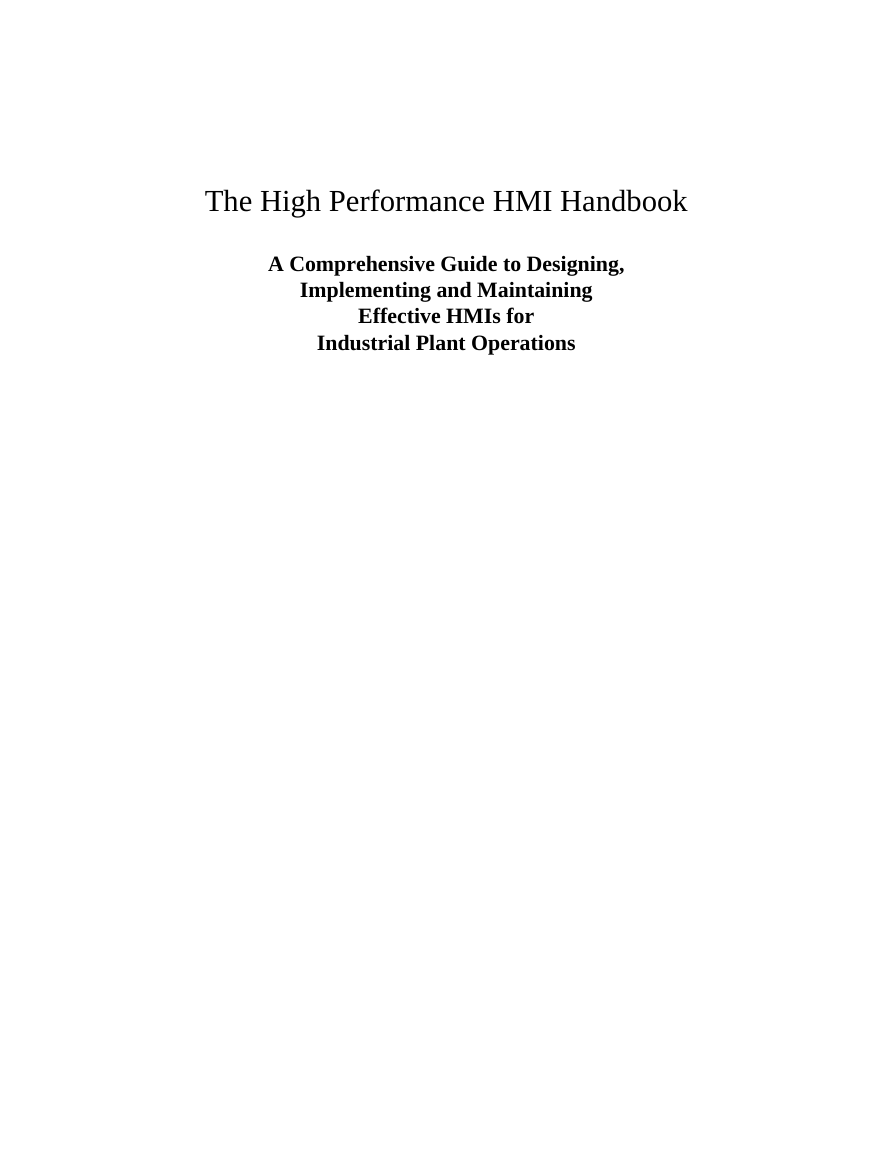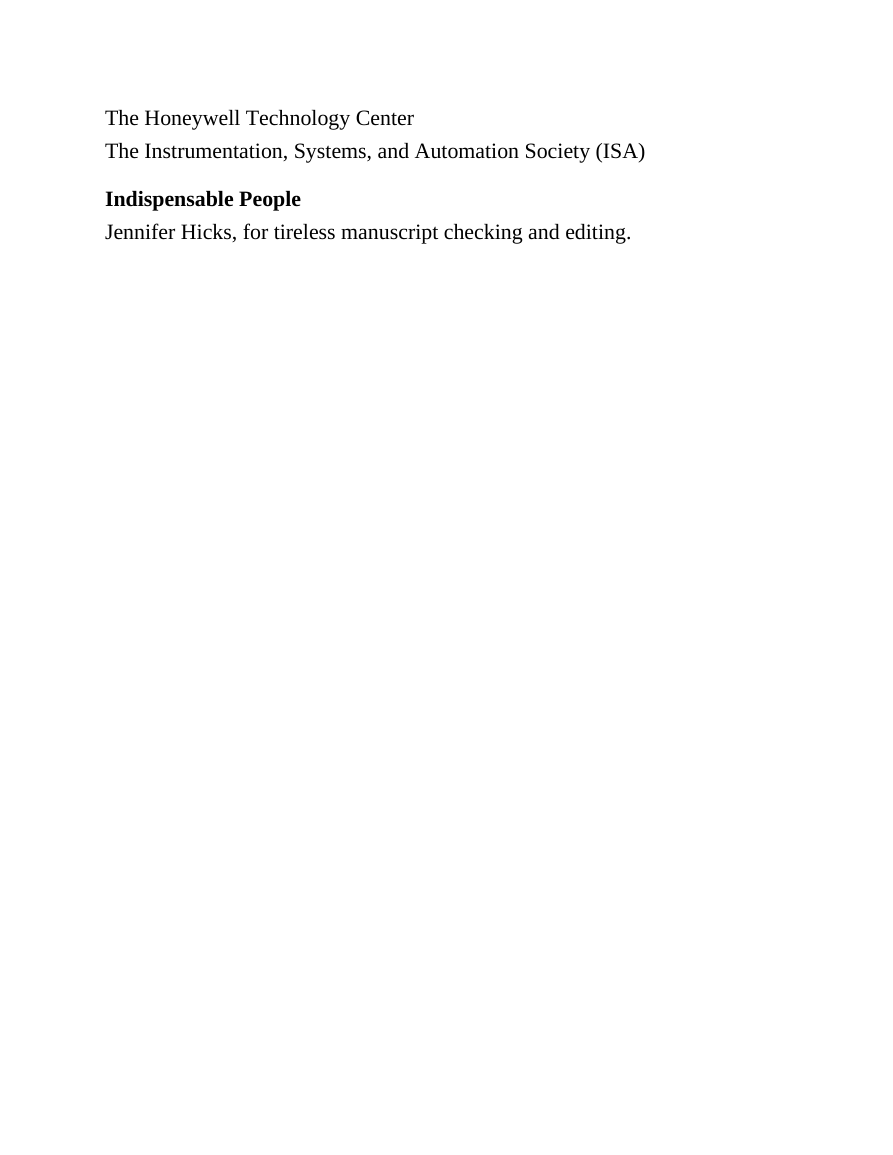Cover Page
Half Title
Title Page
Copyright
Dedication
Acknowledgements
Table of Contents
Detailed Table of Contents
Illustrations
Foreword
PART I: The History and Current Status of the Industrial HMI
Chapter 1: Introduction
1.1: Why This Book Was Written
1.2: Is This Book for You?
1.3: A Word of Warning!
Chapter 2: The State of Industrial HMIs and Operator Graphics
2.1: In the Beginning – the Control Panel
2.2: The Arrival of the Distributed Control System
2.3: Early and Current HMIs
2.4: HMI-Related Problems Arise
2.5: How Did This Happen?
2.6: The Answer to the Problem
2.7: Conclusion
Chapter 3: The Justification for HMI Change
Chapter 4: HMI Best Practices – A Managerial Overview
4.1: Bring Back the Big Picture
4.2: Create Hierarchical, Scenario-Based Displays to Improve Situation Awareness and Response
4.3: Redesign Displays to Emphasize the Most Important Information
4.4: Employ Proper Control Room and Physical Console Design
4.5: Minimize Distractions in the Control Room
4.6: Seven Steps for Creating a High Performance HMI
PART II: Fundamentals of HMI Design and Best Practices
Chapter 5: Assessing HMI Performance
5.1: HMI Evaluation Methodology
5.2: A Failing Grade: “F”
5.3: Not Quite Failing – a “D”
5.4: Still Not Good Enough – a “C”
5.5: Finally – a “B”
5.6: All Right! An “A”
5.7: Periodic Reassessment
Chapter 6: The Development of a High Performance HMI Philosophy and Style Guide
6.1: A First Principle: Users of HMIs
6.2: The HMI Philosophy Document and Style Guide – Overview
6.3: Purpose and Use of a High Performance HMI Philosophy Document
6.4: Development of a High Performance HMI Philosophy Document
6.5: HMI Style Guides
6.6: HMI Objects and Object Libraries
Chapter 7: Basic Principles for High Performance HMIs
7.1: Overview
7.2: The Process Pictorial – An Overused, Low-Performance Paradigm
7.3: Recognizing Good and Bad Graphics at a Glance:
7.4: Data is Not Information!
7.5: Analog is Often Better
7.6: Moving Analog Indicators
7.7: Other Analog Depiction
7.8: The Importance of Trends
7.9: Proper Implementation of Trends
7.10: General Considerations for Displays
7.11: Use of Color
7.12: Standards and Color Conflict
7.13: Depicting Lines, Vessels, and Static Equipment
7.14: Depicting Text
7.15: Depicting Values
7.16: Depicting Vessel Levels
7.18: Depicting Alarm Behavior
7.19: Alarm Priorities
7.20: Alarm Indication Methods
7.21: Alarm Access
7.22: Audible Alarm Indication
7.23: Objects and Symbols
7.24: Process Controllers
7.25: Control Valves and Shutoff Valves
7.26: Instrument Lines
7.27: Depicting Dynamic Equipment
7.28: Depicting Equipment Commands
7.29: Display Layout
7.30: Navigation
7.31: Yoking
7.32: Shutdown Actuation
7.33: Call-up Speed and Performance Expectations
7.34: Depicting Material Balance
Chapter 8: Detailed Design of High Performance Displays
8.1: Display Hierarchy
8.2: Designing Level 1 Process Overview Displays
8.3: Designing Level 2 Process Control Displays
8.4: Startup, Shutdown, and Abnormal Situation Level 2 Displays
8.5: Displaying Interlock Functionality on Level 2 and Level 3 Displays
8.6: Designing Level 3 Process Detail Displays
8.7: Designing Level 4 Process Support and Diagnostic Displays
PART III: Design and Implementation of a High Performance HMI
Chapter 9: The Design and Implementation of High Performance HMI Displays
9.1: Overview
9.2: Determine Specific Performance and Goal Objectives for the Control of the Process, in All Modes of Operation
9.3: Perform Task Analysis to Determine Control Manipulations Needed to Achieve the Performance and Goal Objectives
9.4: Design High Performance Graphics, Using the Design Principles in the HMI Philosophy and Elements From the Style Guide, to Address the Identified Tasks.
9.5: Install, Commission, and Provide Training on the New Displays
9.6: Control, Maintain, and Periodically Reassess the HMI Performance
Chapter 10: Physical Screens and Layout of an Operator Console
10.1: Physical Screens
10.2: General Purpose PC
10.3: Communications Gear
10.4: Multiple Keyboards
10.5: External Video
10.6: Hardwired Switches
10.7: Incorporation of Lightboxes
10.8: Vertically Stacked Displays
10.9: Alternative High Performance Console Layouts
10.9.1: High Performance Console #1: 6 Total Screens in a Horizontal Arrangement
10.9.2: High Performance Console #2: 6 Total Screens in a Semi-Horizontal Arrangement
10.9.3: High Performance Console #3: 6 Total Screens in a 2-Tier arrangement
10.9.4: High Performance Console #4: 8 Total Screens in a Vertically Staggered Arrangement
PART IV: Control Rooms, Abnormal Situation Management, and the Future of the Industrial HMI
Chapter 11: Control Room Design, Layout, Operating, and Management Practices
11.1: Overview
11.2: Early Control Rooms
11.3: The Introduction of Human Factors Design
11.4: Design of New Control Rooms
11.5: Lighting Levels
11.6: Glare and Reflection
11.7: Acoustics
11.8: Music
11.9: Telephones
11.10: Other Distractions
11.11: Workload Analysis
11.12: Console Adjacency and Arrangement
11.13: Video Walls
Chapter 12: Situation Awareness and Abnormal Situation Response
12.1: Stress and Performance
12.2: Performance Shaping Factors
12.3: Abnormal Situation Management Concepts
12.4: Human Problem-Solving Behavior
12.5: Human Errors
12.6: The Distribution of Failure
12.7: The HMI as the Solution
Chapter 13: The Future of the Industrial HMI
Appendices
Appendix 1: High Performance HMI Philosophy Document and Style Guides – Example Tables of Contents
Appendix 2: Assessing HMI Performance
A2-1: General Graphic Factors
A2-2: Navigation Factors
A2-3: Workstation Factors
A2-4: Control Room and Work Practice Factors
A2-5: Alarm Management Factors
A2-6: Operator Questionnaire
A2-7: Testing the High Performance HMI vs. the Traditional HMI
Appendix 3: The PRO “Enhanced Radar Plot” – a Highly Effective HMI Element
Appendix 4: A Brief Overview of Alarm Management
References
About The Authors
















 2023年江西萍乡中考道德与法治真题及答案.doc
2023年江西萍乡中考道德与法治真题及答案.doc 2012年重庆南川中考生物真题及答案.doc
2012年重庆南川中考生物真题及答案.doc 2013年江西师范大学地理学综合及文艺理论基础考研真题.doc
2013年江西师范大学地理学综合及文艺理论基础考研真题.doc 2020年四川甘孜小升初语文真题及答案I卷.doc
2020年四川甘孜小升初语文真题及答案I卷.doc 2020年注册岩土工程师专业基础考试真题及答案.doc
2020年注册岩土工程师专业基础考试真题及答案.doc 2023-2024学年福建省厦门市九年级上学期数学月考试题及答案.doc
2023-2024学年福建省厦门市九年级上学期数学月考试题及答案.doc 2021-2022学年辽宁省沈阳市大东区九年级上学期语文期末试题及答案.doc
2021-2022学年辽宁省沈阳市大东区九年级上学期语文期末试题及答案.doc 2022-2023学年北京东城区初三第一学期物理期末试卷及答案.doc
2022-2023学年北京东城区初三第一学期物理期末试卷及答案.doc 2018上半年江西教师资格初中地理学科知识与教学能力真题及答案.doc
2018上半年江西教师资格初中地理学科知识与教学能力真题及答案.doc 2012年河北国家公务员申论考试真题及答案-省级.doc
2012年河北国家公务员申论考试真题及答案-省级.doc 2020-2021学年江苏省扬州市江都区邵樊片九年级上学期数学第一次质量检测试题及答案.doc
2020-2021学年江苏省扬州市江都区邵樊片九年级上学期数学第一次质量检测试题及答案.doc 2022下半年黑龙江教师资格证中学综合素质真题及答案.doc
2022下半年黑龙江教师资格证中学综合素质真题及答案.doc